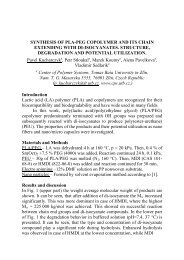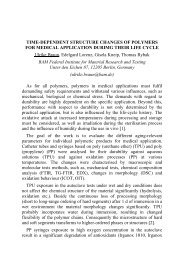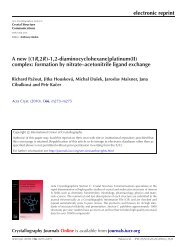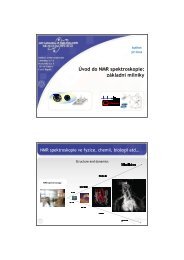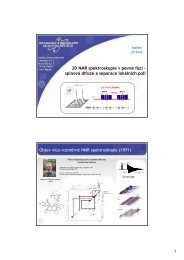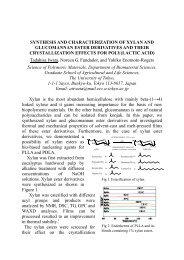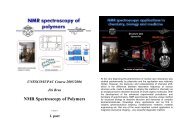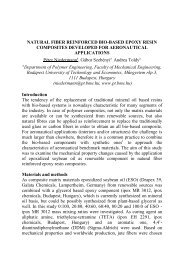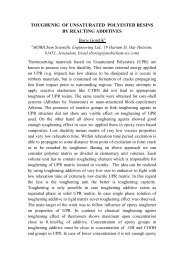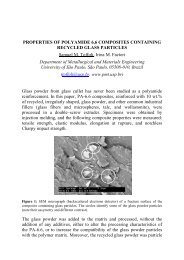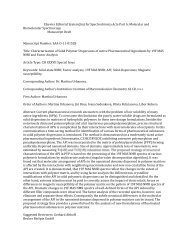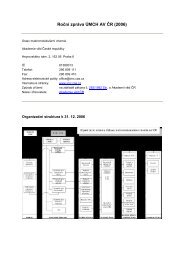Influence of zinc borate on fire protection and thermal degradation of ...
Influence of zinc borate on fire protection and thermal degradation of ...
Influence of zinc borate on fire protection and thermal degradation of ...
You also want an ePaper? Increase the reach of your titles
YUMPU automatically turns print PDFs into web optimized ePapers that Google loves.
INFLUENCE OF ZINC BORATE ON FIRE PROTECTION AND<br />
THERMAL DEGRADATION OF INTUMESCENT COATING<br />
CONTAINING A NOVEL CAGED BICYCLIC PHOSPHATE<br />
You Zhou, Jianwei Hao*, Jianxin Du, Haixu Wen<br />
Nati<strong>on</strong>al Laboratory <str<strong>on</strong>g>of</str<strong>on</strong>g> Flame Retardant Materials, School <str<strong>on</strong>g>of</str<strong>on</strong>g> Materials,<br />
Beijing Institute <str<strong>on</strong>g>of</str<strong>on</strong>g> Technology, 5 south Zh<strong>on</strong>gguancun Street, Haidian<br />
District, Beijing 100081, P. R. China<br />
(hjw@bit.edu.cn)<br />
Keywords: Intumescent; Zinc <str<strong>on</strong>g>borate</str<strong>on</strong>g>; Fire protecti<strong>on</strong>; Coating.<br />
Fire protecti<strong>on</strong> <strong>and</strong> <strong>thermal</strong> degradati<strong>on</strong> <str<strong>on</strong>g>of</str<strong>on</strong>g> intumescent epoxy coatings<br />
with a novel caged bicyclic phosphate (Trimer) [1], APP <strong>and</strong> <str<strong>on</strong>g>zinc</str<strong>on</strong>g> <str<strong>on</strong>g>borate</str<strong>on</strong>g><br />
(ZB) were investigated. The experimental results as follows: compared to<br />
the coatings with ZB, No.1 coating shown the best initial <strong>fire</strong> protecti<strong>on</strong><br />
property up to 300s due to the earliest expansi<strong>on</strong> (Fig 1, Fig 2 <strong>and</strong> Table 1),<br />
however, at a l<strong>on</strong>ger time a plateau was achieved for No.2 <strong>and</strong> No.3<br />
coatings <strong>and</strong> their final <strong>fire</strong> protecti<strong>on</strong> time was increased about 100%<br />
respectively when compared with that <str<strong>on</strong>g>of</str<strong>on</strong>g> No.1 coating. Compared to<br />
calculated TGA curve <str<strong>on</strong>g>of</str<strong>on</strong>g> No.3 coating in N 2 , the experimental <strong>on</strong>e changed<br />
slightly (Fig 3 (a) <strong>and</strong> Table 1), the experimental residue at 700℃ was<br />
increased by 1.5% <strong>on</strong> the base <str<strong>on</strong>g>of</str<strong>on</strong>g> calculated <strong>on</strong>e. Moreover, the difference<br />
was obviously enlarged in air (Fig 3 (b) <strong>and</strong> Table 1), particular at<br />
temperature higher than 550℃, significant improvement was observed in<br />
thermo-oxidative stability <str<strong>on</strong>g>of</str<strong>on</strong>g> coating with the additi<strong>on</strong> <str<strong>on</strong>g>of</str<strong>on</strong>g> 5%ZB. The final<br />
residue <str<strong>on</strong>g>of</str<strong>on</strong>g> No.3 coating was 38.2% at 700℃ compared to 27.0% for No.1<br />
coating <strong>and</strong> the beneficial effect <str<strong>on</strong>g>of</str<strong>on</strong>g> ZB was clearly dem<strong>on</strong>strated as well. It<br />
is <str<strong>on</strong>g>of</str<strong>on</strong>g> interest to notice that the degradati<strong>on</strong> curve <str<strong>on</strong>g>of</str<strong>on</strong>g> Trimer/APP abviously<br />
changed from 480℃ by incorporating ZB <strong>and</strong> the final residue increased<br />
from 14.6% to 47.8% (Fig 4). The 31 P solid-state NMR spectrum (Fig 4)<br />
shown a high peak at -30ppm, which is attributed to B-O-P b<strong>on</strong>ds [2]. This<br />
result further c<strong>on</strong>firmed that the interacti<strong>on</strong> taken place between<br />
Trimer/APP <strong>and</strong> ZB which lead to the formati<strong>on</strong> <str<strong>on</strong>g>of</str<strong>on</strong>g> borophosphate. Above<br />
menti<strong>on</strong>ed results clearly indicated that an appropriate ZB may yield<br />
synergistic effect <strong>on</strong> improving the <strong>thermal</strong> stability <str<strong>on</strong>g>of</str<strong>on</strong>g> coating with<br />
Trimer/APP at high temperature, which could c<strong>on</strong>tribute to enhance the<br />
<strong>fire</strong> protecti<strong>on</strong> property <str<strong>on</strong>g>of</str<strong>on</strong>g> coating.
Temperature (℃)<br />
400<br />
350<br />
300<br />
250<br />
200<br />
150<br />
100<br />
No.4<br />
No.5<br />
No.1<br />
No.3<br />
No.1 coating without ZB<br />
No.2 coating with 3% ZB<br />
No.3 coating with 5% ZB<br />
No.4 coating with 7% ZB<br />
No.5 coating with 9% ZB<br />
No.2<br />
a<br />
b<br />
b<br />
50<br />
0<br />
0 300 600 900 1200 1500 1800 2100<br />
Time (s)<br />
Fig 1. Fire protecti<strong>on</strong> curves <str<strong>on</strong>g>of</str<strong>on</strong>g> coatings. Fig 2. Image <str<strong>on</strong>g>of</str<strong>on</strong>g> (a) No.1 <strong>and</strong> (b) No.3 coatings at<br />
30s in the <strong>fire</strong> protecti<strong>on</strong> test.<br />
(a)<br />
100<br />
(b)<br />
100<br />
90<br />
ZB<br />
90<br />
ZB<br />
80<br />
80<br />
Residue weight (%)<br />
70<br />
60<br />
50<br />
No.3 coating (exp)<br />
Residue weight (%)<br />
70<br />
60<br />
50<br />
40<br />
No. 3 coating (cal)<br />
No.3 coating (exp)<br />
40<br />
30<br />
No.3 coating (cal) No.1 coating<br />
200 300 400 500 600 100 700<br />
Temperarure (℃)<br />
30<br />
20<br />
No.1 coating<br />
100 200 300 400 500 600 700<br />
Temperature (℃)<br />
Fig 3. TGA curves <str<strong>on</strong>g>of</str<strong>on</strong>g> No.1 <strong>and</strong> No.3 coatings in (a) N 2 <strong>and</strong> (b) air.<br />
100<br />
ZB<br />
H 3 PO 4<br />
B-O-P<br />
80<br />
Residue weight (%)<br />
60<br />
40<br />
APP/Trimer/ZB (exp)<br />
APP/Trimer/ZB (cal)<br />
P-O-C<br />
20<br />
APP/Trimer<br />
0<br />
100 200 300 400 500 600 700<br />
Temperature (℃)<br />
20 0 -20 -40<br />
Chemical shift (ppm)<br />
Fig 4. TGA curves <str<strong>on</strong>g>of</str<strong>on</strong>g> Trimer/APP, ZB Fig 5. 31 P solid-state NMR <str<strong>on</strong>g>of</str<strong>on</strong>g> Trimer/APP/ZB<br />
<strong>and</strong> Trimer/APP/ZB in air.<br />
treated at 600℃ in air<br />
Table 1. Fire protecti<strong>on</strong> <strong>and</strong> TGA data <str<strong>on</strong>g>of</str<strong>on</strong>g> coatings<br />
Fire protecti<strong>on</strong> time (s) N 2 , 10℃/min Air, 10℃/min<br />
Samples<br />
250℃ 300℃ 350℃ 400℃ T 5% /℃ CR/%<br />
CR/%<br />
T<br />
(700℃) 5% /℃<br />
(700℃)<br />
No.1 80 200 530 1040 223 37.0 240 27.0<br />
No.3 70 121 1030 1800 224 40.8 260 38.3<br />
Reference<br />
1. Weizh<strong>on</strong>g J, Jianwei H, Zhid<strong>on</strong>g H, Polymer degradati<strong>on</strong> <strong>and</strong> stability. 97:632-637, 2012.<br />
2. Grimmer A R, M¨uller D, G¨ozel G, Kniep R, Fresenius J. Anal. Chem. 357:485-488, 1997.



